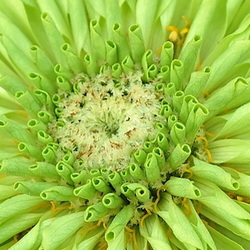 They are one of the easiest plants to start from seeds and they grow so fast that it is somewhat pointless to pay for pricier bedding plants when there is such a short time from seed to bloom. New gardeners can plant them with confidence that they will grow and bloom reliably and fast. Most direct-seeded zinnias will bloom four to six weeks after they are planted, if the ground is warm and conditions are favorable.
They are one of the easiest plants to start from seeds and they grow so fast that it is somewhat pointless to pay for pricier bedding plants when there is such a short time from seed to bloom. New gardeners can plant them with confidence that they will grow and bloom reliably and fast. Most direct-seeded zinnias will bloom four to six weeks after they are planted, if the ground is warm and conditions are favorable.
Zinnias require a sunny area and moderately fertile soil. Work the ground to about 6" deep after danger of frost has passed, removing rocks, grass and weeds. Sprinkle the zinnia seeds between three and six inches apart and lightly cover them with soil. Water well, and you should see seedlings starting to sprout within a week. The little plants should shoot up quickly and to make a bushier display, pinch out the center growing tip when they are between six and eight inches tall. Even if you don't pinch them, they will put on a great show, but this helps the plants stay compact and not as likely to fall over in hard rains.
There are zinnias for every area of the garden...and containers too! From the tiny little fellows that make a great front of the border, to the giants that tower over the rear, surely there's one that works. Even if you have a preference for a specific color, many vendors offer color-sorted seeds. If you have your heart set on giant red flowers or the neon combination of purple and chartreuse, chances are, it is available.
 Zinnias are surprisingly drought-hardy when established. They aren't going to work in a xeriscape garden, but will survive more new gardener neglect than ferns or petunias. They do need about an inch of water a week, and if they are container-grown, a bit more. Water your zinnias in the morning as their only weakness is powdery mildew. Powdery mildew is a fungus that thrives in damp, humid conditions, so keeping the leaves dry with good air circulation is the best prevention. This all circles back to not overcrowding your zinnia plants, so don't be tempted to sow your seeds thicker than recommended.
Zinnias are surprisingly drought-hardy when established. They aren't going to work in a xeriscape garden, but will survive more new gardener neglect than ferns or petunias. They do need about an inch of water a week, and if they are container-grown, a bit more. Water your zinnias in the morning as their only weakness is powdery mildew. Powdery mildew is a fungus that thrives in damp, humid conditions, so keeping the leaves dry with good air circulation is the best prevention. This all circles back to not overcrowding your zinnia plants, so don't be tempted to sow your seeds thicker than recommended.
Zinnias make great cut flowers. This makes them ideal for children's gardens. The kids can make bouquets for parents, teachers, grandparents and neighbors, since cutting the flowers only prompts the plant to produce more. Clip the stems early in the morning and only take flowers that are just before their peak. This will ensure that the bouquet is colorful and long-lasting.
 Butterflies love zinnias too. Gardeners that plant to attract colorful winged visitors won't be disappointed with zinnias. The flowers are irresistible to our winged friends and it isn't unusual to see many species dancing among zinnia blooms on a sunny day. The large, flat-topped varieties are the most attractive to butterflies, giving them the perfect 'landing pad' to sip nectar.
Butterflies love zinnias too. Gardeners that plant to attract colorful winged visitors won't be disappointed with zinnias. The flowers are irresistible to our winged friends and it isn't unusual to see many species dancing among zinnia blooms on a sunny day. The large, flat-topped varieties are the most attractive to butterflies, giving them the perfect 'landing pad' to sip nectar.
Gardeners with reasonably long summers can plant zinnias 3 or four weeks apart in succession plantings, so when one group starts looking tired, another one is ready to shine. Here in west KY, we plant zinnias again at the end of July for a great show that will take us through the rest of the summer and on into autumn. The first group that was planted in mid-April usually looks great until sometime in August, but the new plants are ready to bloom by then.
New gardeners should pick up a pack or two of zinnias. They're easy, put on a great show and brighten up any garden.

















